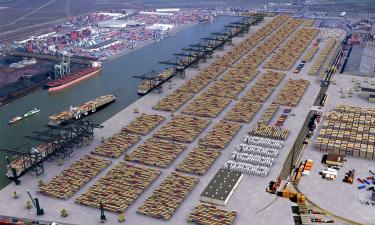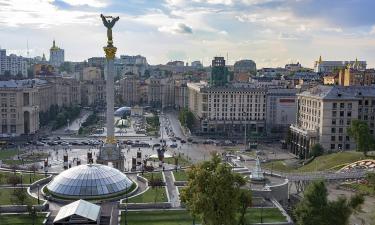Burrows of Prominent War Commanders
WWII left several ferroconcrete stamps on the planets, underground bunkers of Churchill, Hitler, Stalin. The tradition was maintained by Saddam Hussein who built a huge autonomous bunker capable to endure an earthquake of 6 points Richter scale. And the bunker proves to be strong enough.
The necessity to build an underground was first mentioned in London in 1938. Already in autumn, after the Munich crisis when "mutual understanding with Hitler was achieved", construction of a bunker was started. A week before Britain's joined the war, a map room was opened in the bunker in King Charles street, it was some kind of a center where the situation in the world was studied. The first meeting of British strategists presided by Chamberlain was held in Winston Churchill's "war office" at the end of October 1939 (Churchill was the Navy minister at that time). When Churchill became the head of the government, he understood that European campaign would last for a very long time.
On May 14, 1940 Holland surrendered to Hitler, he swallowed Belgium in 14 days, then France's capitulation followed. The British prime minister said that right from the bunker he would monitor the war and settled in the bunker's room 65a where he had an office and a bedroom.
Planning of the bunker resembles the arrangement of cabins of a ship: they are all built along the board and open on a long corridor. A steel door to the bunker is battened down like a ship door. Everyday activity of the wartime command post is in full swing behind the door even now: teletype is rattling, telephones are ringing, telephone girls in dresses made according to the fashion of the 1940s answer the phones. This is not in the literal sense of the words indeed. Like majority of the British museums, Churchill's bunker is supplied with sounds to make it look more believable from a historic point of view. Dummies in uniform liven the interior up. From time to time, glasses clink in the once super secret war object: after making particular payment, people can celebrate any event in the bunker.
Hitler's field headquarters called Werwolf near the Ukrainian city Vinnitsa is still enveloped with fantasies. The name of the headquarters is often translated as "a werewolf", but the exact translation of the word is "an armed wolf". German authors explain this name with the fact that Adolph means "wolf" in the old German language.
The idea to build bunkers occurred to the Fuhrer long before WWII. Before the construction was started, Hitler asked about 400 astrologers, extrasensory individuals and parapsychologists working at the occult sciences institute he created to find out whether sites chosen for construction of bunkers were good.
The Fuhrer had comfortable hide-outs all over Europe. He had nine stationary headquarters including the bunker under the Berlin Reich Chancellery. Some were on the territory of Germany and others outside the country. In the eastern front, a bunker was planned to be constructed near the Ukrainian city of Lubni, but the failure near Moscow and partisan activity made Hitler build the bunker in a quieter place, in the city of Vinnitsa. It was believed that the place wasn't involved in partisan activity. On the contrary, the chief of Vinnitsa police reported about partisan activity in the place: "Saboteurs organized groups in 1941-1942 for destruction of communication and railway means in the enemy's rear as far as the front moved away. This is done to cut possible ways of German army's withdrawal. It is rumored in partisan groups that Germany's eastern front will be smashed soon."
Construction of Werwolf started at the end of 1941; a special document was issued on April 10, 1942 to inform that the construction was over. In accordance with the document, 4,086 people were involved in the construction works; they were 991 Germans, 1,425 foreigners, about 500 soldiers and 1,100 prisoners of war. Hitler's commanders thanked the workers for the good job, paid good money and even organized a farewell party. The people got on board a plane, and the plane blew up in the air.
Those who built the bunker also established 24-hour communication with Berlin, Kiev, Kharkov and other Ukrainian cities: a powerful telephone cable was laid from the underground headquarters along the Vinnitsa-Zhitomir highway. The cable is in good condition and is operated even now.
Germans took every effort to keep Werwolf a secret, but they were not a success. There are several versions suggesting who probably informed Moscow about the bunker of Hitler in Ukraine. It is known that first information concerning the bunker construction was reported by an underground organization in Kiev. The head of the organization learnt the information from a Gestapo soldier whom he had known before.
The secret of the headquarters was also revealed by Germanpilot Franz Berebrok who was in the bunker in the summer of 1942, where Hitler awarded him with an Iron Cross for the 100th plane he had brought down. The pilot was taken prisoner near the Russian city of Velikie Luki and betrayed the secret.
What was Stalin's reaction to this kind of information reported by the Central Intelligence Department? The Soviet commander-in-chief didn't publish information about field headquarters on the territory of the Soviet territory on purpose. For him to admit presence of Hitler on the temporarily occupied territories meant to recognize the falseness of the official Soviet propaganda that depicted Hitler as a coward.
The Werwolf underground headquarters was enveloped with more and more fantasies with the time. A very interesting publication appeared in the Soviet newspaper Pravda on December 24, 1992. It was reported that during Stalingrad fighting on December 22, 1942, bombers and fighters destroyed objects of Hitler's field headquarters. Why isn't there any document or verbal report confirming the successful raid? And what is more, how was it possible to reconstruct "the destroyed objects" by the Fuhrer's arrival in 1943?
Several books and periodicals mentioned that Hitler was exposed to radiation in Werwolf, and the dose was lethal. When a spectral analysis was held in the place from where granite was taken for construction of the bunker, it turned out that the stone mined there contained high-level radium, the source of the strongest alpha-emission.
This doesn't seem to be a really scary fact to anyone. A tender was announced for usage of Hitler's field headquarter. Not only scientific workers have some considerable concern in Werwolf, businessmen expect that tourism in the place will return great profits for them. But local population of Vinnitsa where the bunker is situated say that it contains lots of explosives. So, as they say, there may be danger to be blown up.
Hitler's aggression gave rise to construction of bunkers in the Soviet Union. Installation works were started in an Air Defense bunker under Smolenskaya (now Tverskaya) square in Moscow. There was also a "burrow" in Moscow's Myasnitskaya Street, but Stalin never came there. Several years before the war, the possibility of transfer of the Soviet capital to the city of Kuibyshev (now Samara) in a emergency situation was considered. When this situation occurred in the Soviet Union in October 1941, the political and military leaders of the country decided to leave for Kuibyshev. When Moscow specialists for metro construction arrived in the city, tunnel works had been already completed and two mined were practically ready there. The works were done by prisoners who found their grave right in the bunker.
What was Stalin's bunker like? The total square of the bunker was 200 square meters. It had an elevator. Just to compare: while the bunkers of Churchill and Roosevelt were situated on the level of two floors under the ground, Stalin's "burrow" was 12 floors deep. On the very bottom of the bunker Stalin had an office which at the same time was used as an assembly room for the Political Bureau. But Stalin never took rest in the comfortable rooms of the bunker. German troops were thrown back from the Soviet capital and Stalin stayed in Moscow.
On the eve of a possible invasion of the USA to Iraq, Saddam Hussein took measures to guarantee his private security. Bunker Abu Makhabi (the name means the father of bomb-proof shelters) situated in the southern suburb of Baghdad, in Ad-Durra has already endured strikes of four American missiles.
The headquarters called Today is Hussein's 5-storey "burrow" at the value of $60 million. The construction is covered with a 2-meter concrete layer, it has storage rooms for water and fuel, reserve accumulators, air and water filters, a command post and a complicated door system. The hemispheric construction of the shelter can change the path of a bomb producing a ricochet effect. It is possible to penetrate into the bunker of 1,800 square meters only with the help of elevators.
German engineer Karl Esser who built the unique bunker in 1984 says the construction can be destroyed only with a direct hit of a small nuclear bomb. There are modern non-nuclear bombs that the Pentagon calls "bunker destroyers"; they weigh over 2 tons and have a special warhead that blasts only after the bomb gets under the ground. But the engineer says the power of bombs that Americans have, won't be enough to destroy Saddam's bunker. So, the Iraqi war is a real test for Saddam's bunker.
The Segodnya newspaper Kiev, Ukraine
Translated by Maria Gousseva
Read the original in Russian: https://www.pravda.ru/world/33158-bunker/
Related links:
Subscribe to Pravda.Ru Telegram channel, Facebook, RSS!





